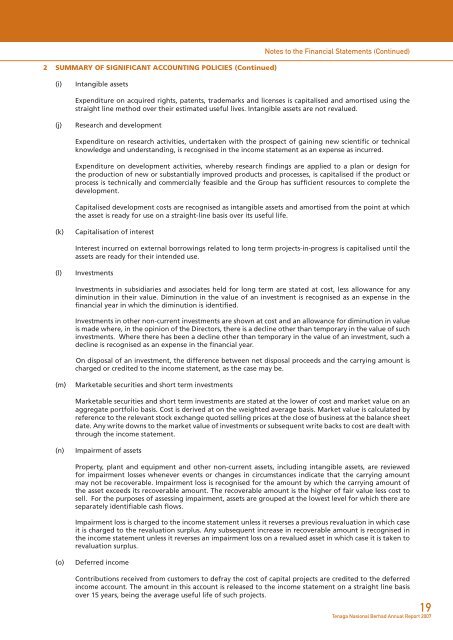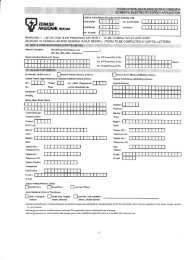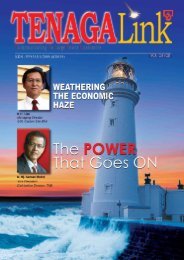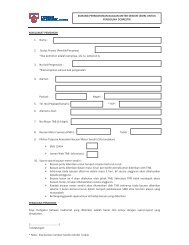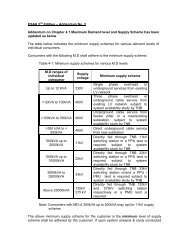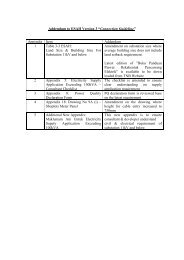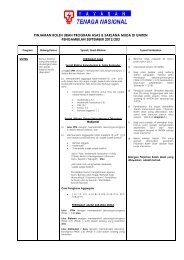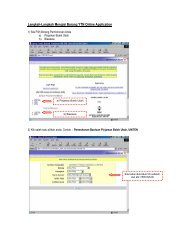Download - Tenaga Nasional Berhad
Download - Tenaga Nasional Berhad
Download - Tenaga Nasional Berhad
You also want an ePaper? Increase the reach of your titles
YUMPU automatically turns print PDFs into web optimized ePapers that Google loves.
2 SUMMARY OF SIGNIFICANT ACCOUNTING POLICIES (Continued)<br />
Notes to the Financial Statements (Continued)<br />
(i)<br />
Intangible assets<br />
Expenditure on acquired rights, patents, trademarks and licenses is capitalised and amortised using the<br />
straight line method over their estimated useful lives. Intangible assets are not revalued.<br />
(j)<br />
Research and development<br />
Expenditure on research activities, undertaken with the prospect of gaining new scientific or technical<br />
knowledge and understanding, is recognised in the income statement as an expense as incurred.<br />
Expenditure on development activities, whereby research findings are applied to a plan or design for<br />
the production of new or substantially improved products and processes, is capitalised if the product or<br />
process is technically and commercially feasible and the Group has sufficient resources to complete the<br />
development.<br />
Capitalised development costs are recognised as intangible assets and amortised from the point at which<br />
the asset is ready for use on a straight-line basis over its useful life.<br />
(k)<br />
Capitalisation of interest<br />
Interest incurred on external borrowings related to long term projects-in-progress is capitalised until the<br />
assets are ready for their intended use.<br />
(l)<br />
Investments<br />
Investments in subsidiaries and associates held for long term are stated at cost, less allowance for any<br />
diminution in their value. Diminution in the value of an investment is recognised as an expense in the<br />
financial year in which the diminution is identified.<br />
Investments in other non-current investments are shown at cost and an allowance for diminution in value<br />
is made where, in the opinion of the Directors, there is a decline other than temporary in the value of such<br />
investments. Where there has been a decline other than temporary in the value of an investment, such a<br />
decline is recognised as an expense in the financial year.<br />
On disposal of an investment, the difference between net disposal proceeds and the carrying amount is<br />
charged or credited to the income statement, as the case may be.<br />
(m)<br />
Marketable securities and short term investments<br />
Marketable securities and short term investments are stated at the lower of cost and market value on an<br />
aggregate portfolio basis. Cost is derived at on the weighted average basis. Market value is calculated by<br />
reference to the relevant stock exchange quoted selling prices at the close of business at the balance sheet<br />
date. Any write downs to the market value of investments or subsequent write backs to cost are dealt with<br />
through the income statement.<br />
(n)<br />
Impairment of assets<br />
Property, plant and equipment and other non-current assets, including intangible assets, are reviewed<br />
for impairment losses whenever events or changes in circumstances indicate that the carrying amount<br />
may not be recoverable. Impairment loss is recognised for the amount by which the carrying amount of<br />
the asset exceeds its recoverable amount. The recoverable amount is the higher of fair value less cost to<br />
sell. For the purposes of assessing impairment, assets are grouped at the lowest level for which there are<br />
separately identifiable cash flows.<br />
Impairment loss is charged to the income statement unless it reverses a previous revaluation in which case<br />
it is charged to the revaluation surplus. Any subsequent increase in recoverable amount is recognised in<br />
the income statement unless it reverses an impairment loss on a revalued asset in which case it is taken to<br />
revaluation surplus.<br />
(o)<br />
Deferred income<br />
Contributions received from customers to defray the cost of capital projects are credited to the deferred<br />
income account. The amount in this account is released to the income statement on a straight line basis<br />
over 15 years, being the average useful life of such projects.<br />
19<br />
<strong>Tenaga</strong> <strong>Nasional</strong> <strong>Berhad</strong> Annual Report 2007


